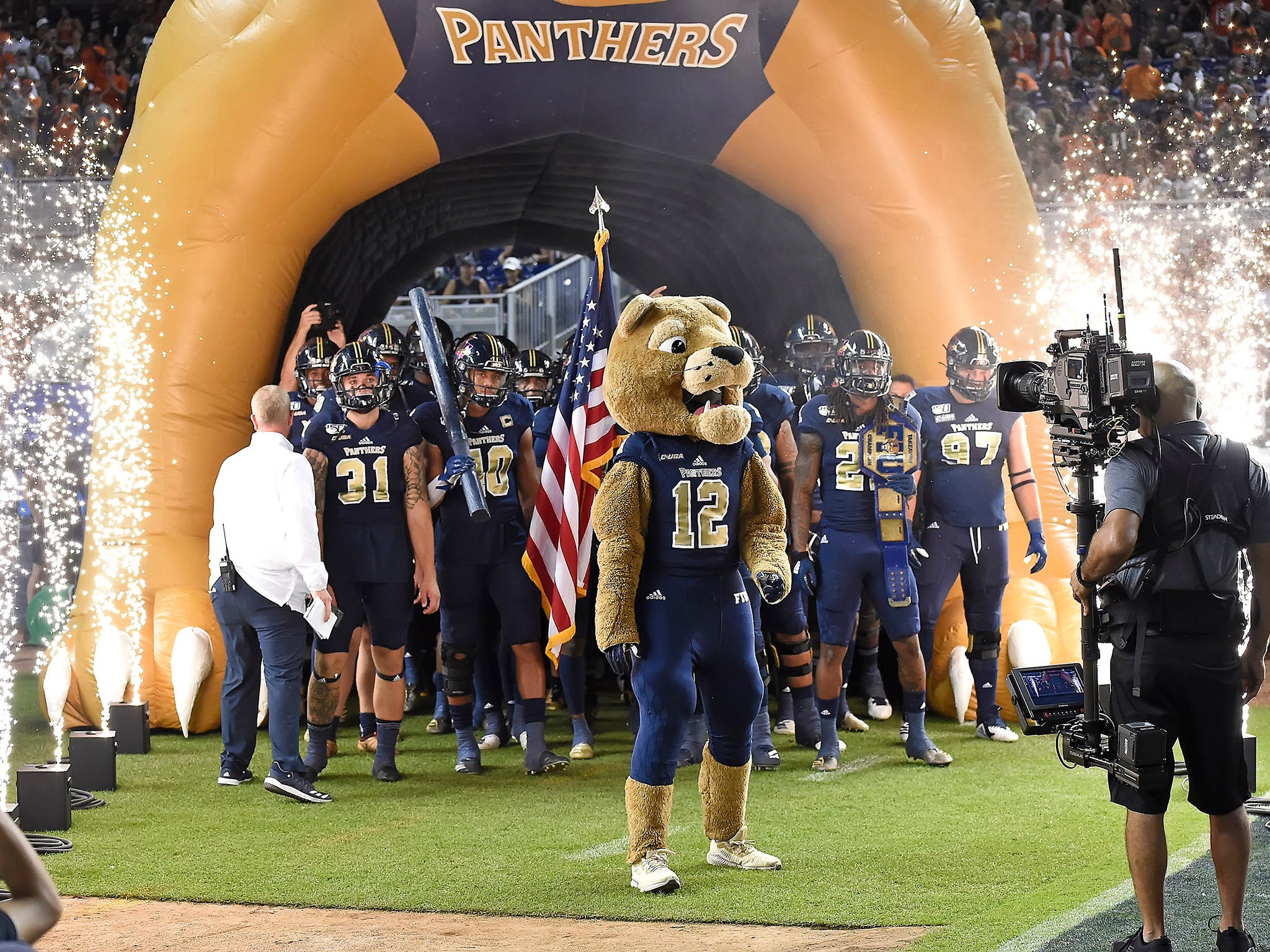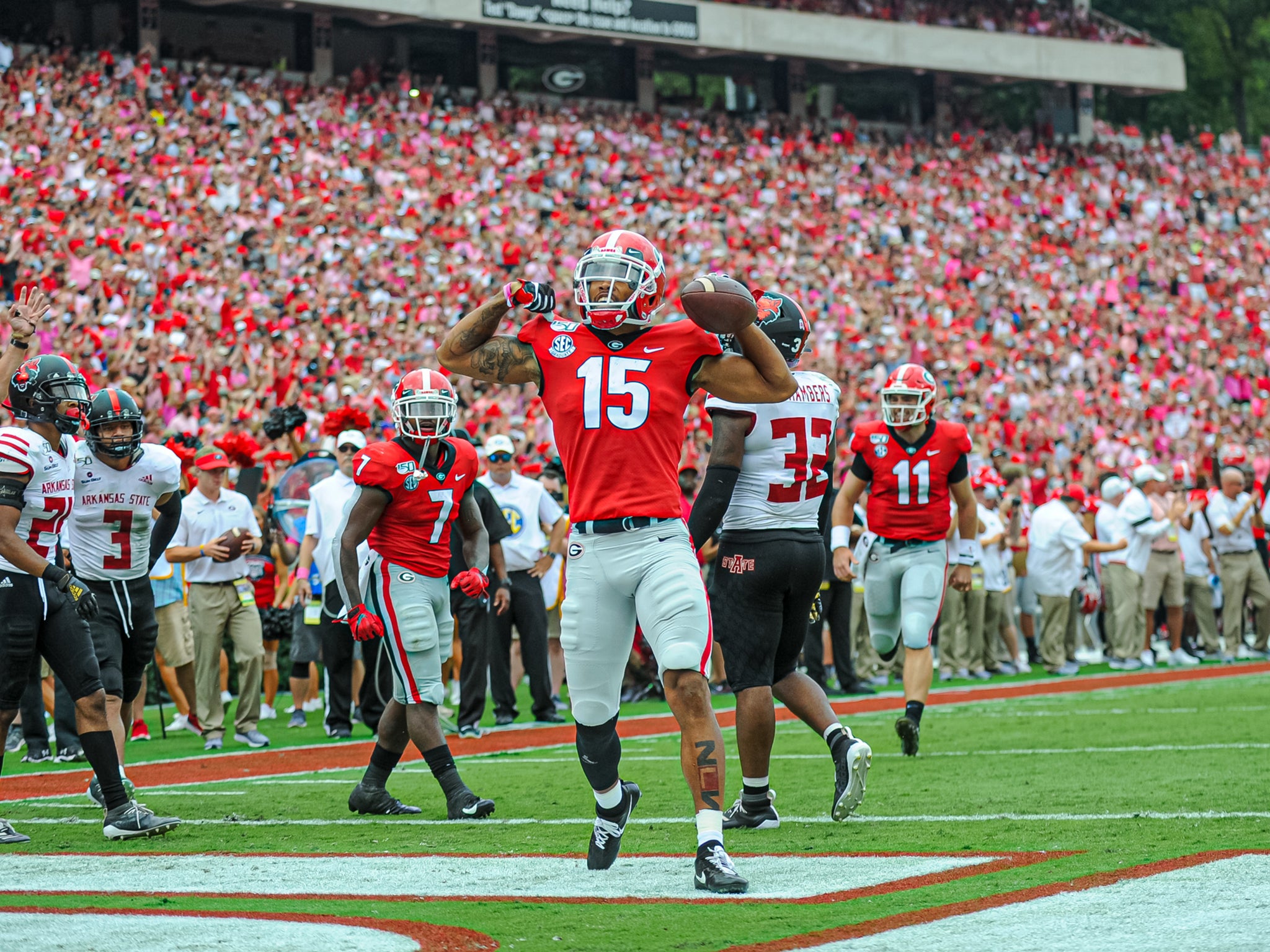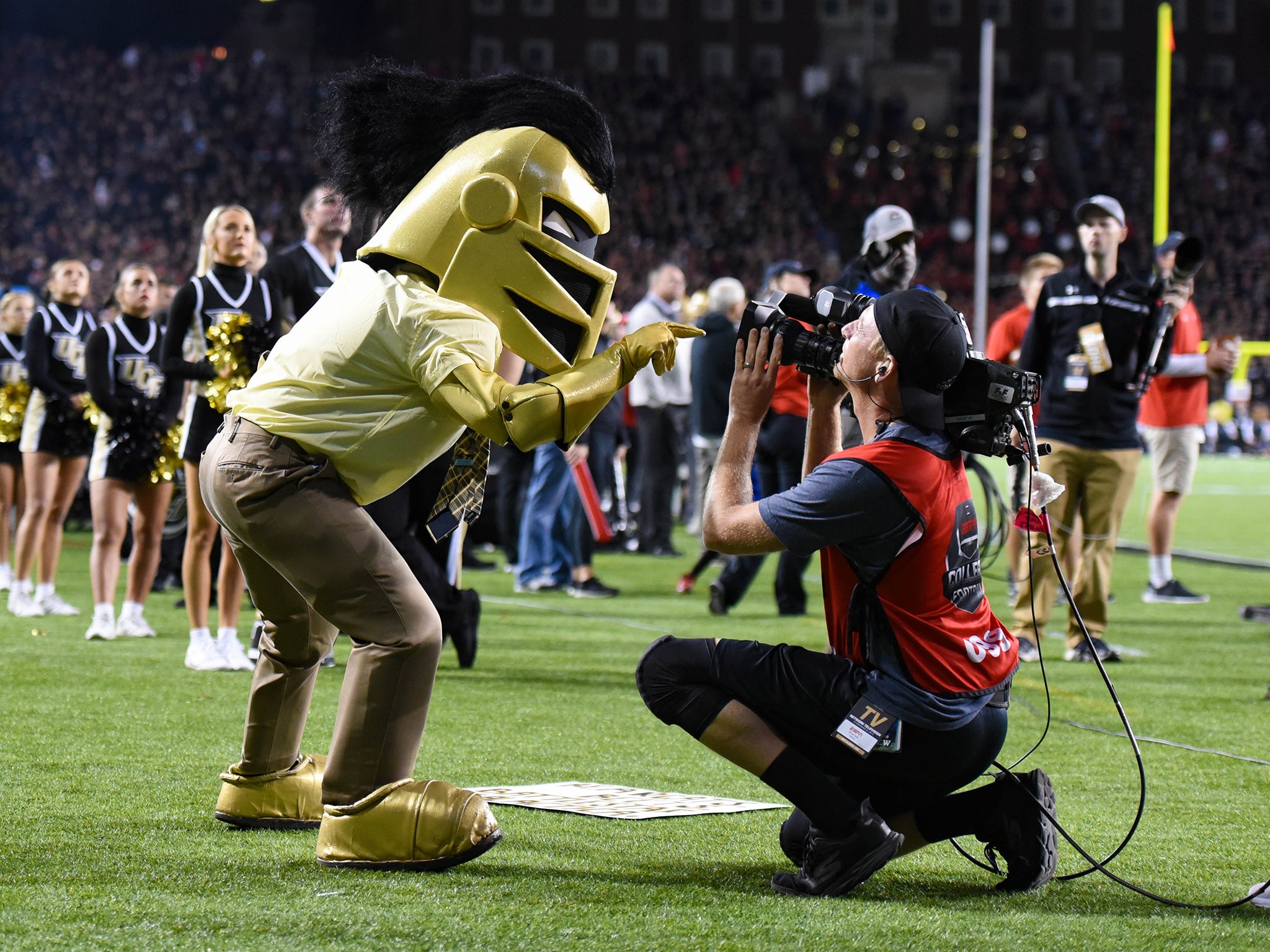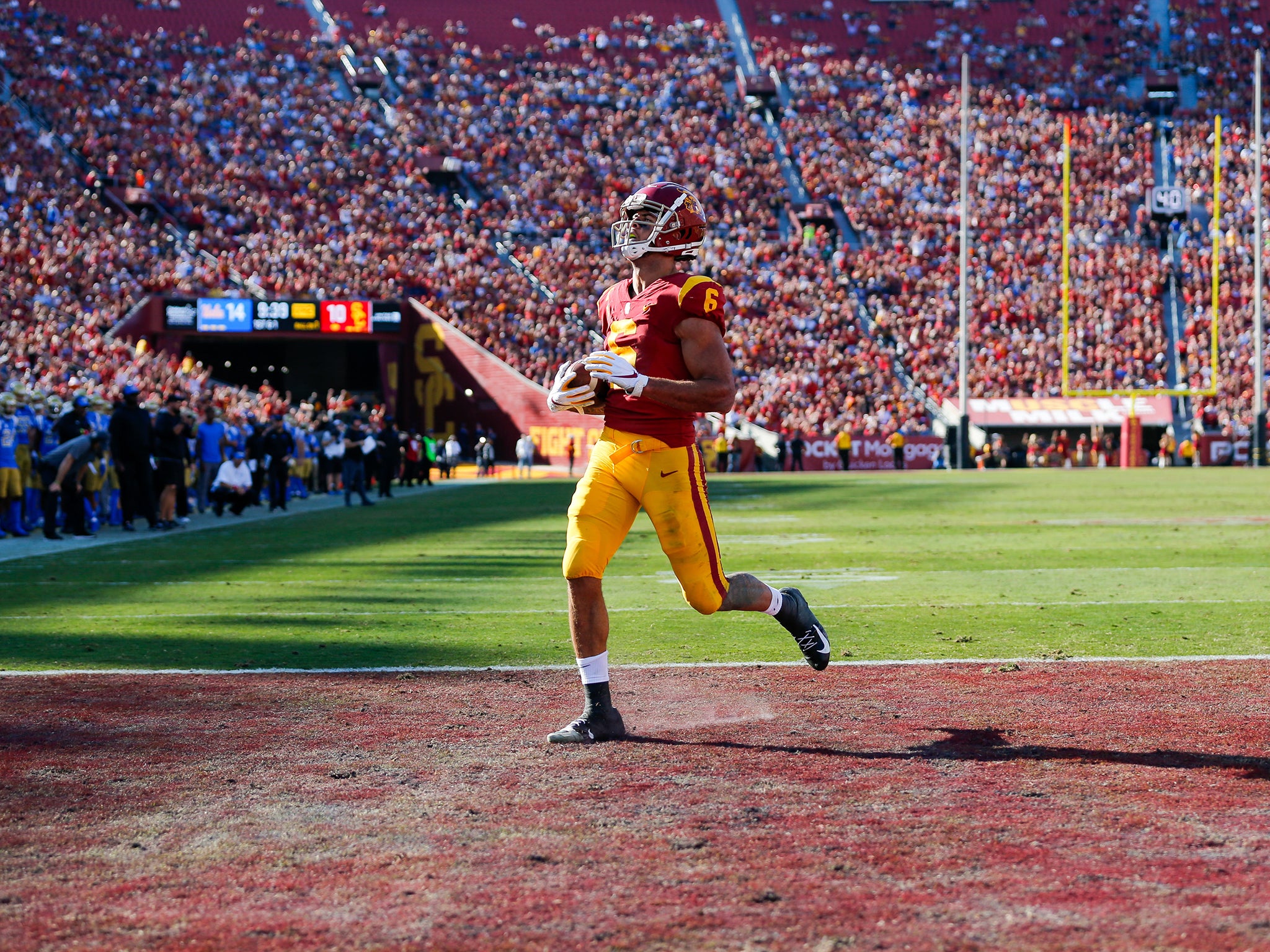Bobbleheads, gift cards and running backs: the weird and wonderful world of US college football
The appeal of American football is that it’s basically chess with violence, writes James Moore, as he shares his passion for the world’s only multibillion-dollar sporting enterprise operated by institutions of higher learning


Everyone’s heard of the Super Bowl but what about the Camellia Bowl? Or the Famous Idaho Potato Bowl? No, I haven’t been over indulging at an early pre-Christmas lunch. These are real games played by real American football teams, just of the college variety. The NFL has just the one big super-duper all-singing all-dancing TV ratings crazy bowl game. College football, where its stars earn their spurs in what the University of Texas quarterback Sam Ehlinger described as an “unpaid full-time internship” for three or four years, has 39 of them. There are 40 if you include college football’s national championship game. Except that doesn’t call itself a bowl.
Confused? The college version of the game is quite good at that. It doesn’t always make a lot of sense. For a start, it’s the world’s only multibillion-dollar sporting enterprise that is operated by institutions of higher learning.
This isn’t the University of Leicester playing the University of Nottingham at football in front of a few pals from the player’s halls of residence, a couple of dog-walkers and one or two family members. The games attract huge crowds and millions of TV viewers. Some of them come from the UK: BT Sport has held the UK rights since its inception in 2013, airing 143 games this year, 123 of them live. The bowl season is treat for gridiron fans. There is a game almost every day from 20 December until the new year. Some of them are wildly entertaining. That might include the famous Idaho Potato Bowl.
This isn’t the University of Leicester playing the University of Nottingham at football in front of a few pals – the games attract huge crowds and millions of TV viewers
Did I mention that the championship line-up is decided by a committee?
Here’s how it all works
First a run through the basics. At the top level Football Bowl Subdivision there are ten separate leagues, or conferences. Schools play a 12-game slate made up of usually eight or nine “in conference” games, plus a selection of external opponents. Often these renew historical rivalries. So the University of Florida, which plays in the South Eastern Conference (SEC), faces off against Florida State, a member of the Atlantic Coast Conference (ACC) every year. A small number of independent schools (most famously the University of Notre Dame) also exist, which construct their own schedules.

One problem that bedevils the support is that powerful programmes regularly fill up their slates with cupcakes from lower levels of competition. This is to avoid losing games. The Playoff Committee is supposed to take strength of schedule into account when selecting for the four team tournament. But this hasn’t stopped schools deliberately scheduling mismatches which can result in some very dull regular season games.
They do it because it pays. No two loss team has ever made the final four. Had the two loss University of Oregon, which won the PAC 12 conference this year, scheduled, say, San Jose State rather than the powerful Auburn University, one of its two losses, as a non-conference opponent it might have sneaked in as a fourth seed. As it is, it’s on the outside looking in.
The committee usually selects what it sees as the four best conference championship winners from the five most powerful conferences (the ACC, SEC, Big 12, Pac-12 and Big 10). But that’s not always the case. The 2017 tournament saw Ohio State of the Big 10 chosen over Penn State, which it en route to winning the Big 10 conference Penn State had two loses but Ohio State, with just the one, was reckoned the better team. It ultimately got mauled by the eventual National Champion, Clemson.
A bitterly disappointed Penn State, meanwhile, went to the Rose Bowl where it suffered a narrow loss to the University of Southern California (USC), which was never in the playoff discussion. But at least they all stood a chance at the beginning of the year. The members of the weaker “Group of Five” conferences stand no chance of getting picked even if they go undefeated, as the University of Central Florida did in 2018. But they only need to win half their games to get a spot in one of the bowl games, so there is that.
Sound bonkers? College football is. But committee’s deliberations, and the rankings it produces, generate impassioned debate. There’s a vibrant media covering them, and they fuel the sort of passionate fan interest that British football fans could well understand but the NFL sometimes struggles to match. Then there are those TV ratings.

This year’s “game of the century” clash between the then top-ranked Alabama and the second-ranking Louisiana State (the south is arguably the game’s spiritual home) pulled in 16.6 million viewers. That’s some way behind the Houston Texans prime time 28-22 victory over the New England Patriots in the NFL’s week 13 which averaged 21.4 million viewers. But it beat all but decisive final two matches in the NBA’s six game finals series between the Toronto Raptors and the Golden State Warriors.
So not bad for a regional sport played by students.
What’s maddening about college football?
You can start with its amateurism. The highest-paid public employee in most US states will usually be the college football, or more rarely, the college basketball coach at one of the biggest public universities. Nick Saban was scheduled to make $8.7m (£6.6m) this year for coaching the University of Alabama, according to USA Today. Texas A&M University handed its coach, Jimbo Fisher, a $75m, 10-year deal in an attempt to knock him off his perch. The difficulty of doing that, and the hunger for success among the rabid fan bases of that conference’s member schools, means most SEC coaches don’t last long. But the pay-offs for ousted coaches can be quite handsome. Over in the ACC, for example, Florida State had to pay $22m just to get rid of Willie Taggart.
All that cash is before any extras coaches make from commercials, or broadcasting work, of which there is usually plenty. These salaries are paid for by a booming market for the TV rights. The SEC currently gets $55m a year from broadcaster CBS and that’s a slam dunk bargain given the ratings it delivers. There’s been talk that its package could go for as much as $300m a year next time around.
The players, the stars of the show, face suspensions if they so much as accept $10 for signing an autograph under the strict amateurism the game’s governing body enforces
Yet the players, the stars of the show, face suspensions if they so much as accept $10 for signing an autograph under the strict amateurism the governing National College Athletic Association (NCAA) enforces. Hence Ehlinger’s ”unpaid full-time internship” comment. There’s also the fact that the best players are mostly black while the absurdly well remunerated coaches, and the athletic directors schools employ to hire them, are typically white. The optics of the that are… questionable to say the least.
Change is coming, not least because US legislators have woken up to just how unjust this set up is so players should soon at least be able to make money of their names, images and likenesses, although how this might work is still up for debate (the Olympic model would be a sensible one to mimic but while the people who run college football are very good at generating revenues they aren’t always very sensible).

Despite its contradictions and the ambivalence one can’t help but feel about its financial arrangements, college football is still great fun, a superb product from the perspective of the spectator. The 36 bowl games that will be broadcast by BT, including the semi-finals and championship game, will be a mix of the good, the bad and the ugly.
So tell me more about these bowls. Do they matter?
Well, up to a point. A bowl game used to be a reward for a good season, a chance to strut your stuff one last time, hopefully on TV. There were only a few of them but the number has gradually expanded because they’ve proven popular with viewers and they’re good way to pad out schedules. There are now so many that sometimes less successful schools sneak in to fill out the roster of games, although that won’t happen this year. They’re good news for the coaches, who can often secure bonuses for getting in. And the players? Well they can at least get some swag!
In soccer terms, you could think of them as part of college football’s Football League championship when compared to the Premier League of the ‘Power Five’ leagues
Bowls are allowed to hand out stuff like personalised bobbleheads, cowboy hats, beach towels and um, a Yeti Rambler? Apparently they hold drinks and were presented to the players in last year’s Bahamas Bowl. US sports media typically rank them in terms of watchability. Last year Sports Illustrated ranked the swag too. The more sensible games give out gift cards. But that didn’t work out so well on one notorious occasion. Tight end Jeremy Sprinkle ended up getting accused of stealing from a department store he’d been given a $450 gift card for as part of his Belk Bowl swag and was suspended for the game. He did make the NFL, though. Only a small minority of college players do that (about 1 per cent). However, I’m not entirely sure you can say that it ended well for Sprinkle given that he now plays for the sad-sack Washington Redskins.
Why would I watch bowls featuring two middling teams from middling leagues?
You mean like the Camellia Bowl featuring the Florida International University Panthers, which plays in Conference USA and went 6-6 this season, facing off against the 7-5 Arkansas State Red Wolves of the Sun Belt? Unofficially those two conferences are part of the second tier Group of Five, and most of those in the know would tell you that they’re at the lower end of it. In soccer terms, you could think of them as part of college football’s Football League championship when compared to the Premier League of the “Power Five” leagues.
Thing is, the championship is fun. A lot of lower-tier Premier League fans will tell you they enjoy life more at the lower level because they win more and the football is fast and exciting. Lower-level bowl games can be fast and exciting and a lot of fun too. Will the Camellia Bowl be like that? It depends on whether FIU can keep a lid on the Red Wolves’ high scoring offence. If the game does turn out to be a bit of a snooze, there’s always Netflix.
Come on, I need more than that
Bowl games also offer a chance to get an early look at the next crop of NFL rookies. The best, those predicted to go in the top of the first round of the annual NFL draft have, it’s true, taken to skipping bowls if they’re not playing for one of the four teams selected for the playoff before they make the jump. That’s smart. Why put a multimillion-dollar signing bonus at risk for the gift card that comes with your final college game, which counts for nothing more than pride for you and a bonus for the coach? But there are plenty of other less big name prospects who will use their bowls as an opportunity to impress NFL scouts.
Another plus point is that the college game is often a test bed for future NFL strategies. It was in college that black quarterbacks first started to emerge. Ditto spread offences and more besides. There’s also more variety on show. The appeal of American football is that it’s basically chess with violence. The strategies employed by college coaches are more varied than what you’ll typically see at the top level.
College game is often a test bed for future NFL strategies; it was in college that black quarterbacks first started to emerge; ditto spread offences and more besides
Unlike in the NFL, where the quarterback is king, a lot of college teams are still built around their running backs and it’s not unusual for the latter to average comfortably in excess of five yards a carry, or even more, because NFL quality backs can get through college level defences like a knife through butter.
If, like me, you grew up watching Marcus Allen, Eric Dickerson and Walter Payton on Channel 4 and developed an appreciation for running football, you’ll be well catered for. It reaches its zenith with the service academies that might go through an entire game without completing a single pass. Here’s where you’ll see the origin of some of the things the Baltimore Ravens are doing with Lamar Jackson. Army, Navy and Air Force, all run their own variation on the run heavy triple-option attack. It used to be used by everyone but is now something of a relic that nonetheless gives defences nightmares because of its rarity.
It isn’t conservatism that keeps those three schools using it. With sky-high academic requirements, the fact that students have to sign up to serve in the military for five years which can complicate life for NFL prospects, and weight limits that prevent these schools from recruiting giant offensive linemen, they have to do something different to compete at the top level.
Watching one or another of them them befuddle the defences of more normally constructed college teams in their bowl games can be a lot of fun. Navy plays Kansas State in the Liberty Bowl on 31 December, while Air Force plays in the (ahem) Cheez-It Bowl on 27 December. Put that one in your diary. Its opponent will be Washington State, whose coach Mike Leach developed the pass happy air raid attack. You could scarcely get two more contrasting styles. Variety is the spice of college football life.
Trick plays too
College teams spend much of their season doing their damnedest to get to a bowl game. When they arrive, the pressure’s off for those not competing in the playoff. So some of the more open minded coaches have a bit of fun with reverses, flea flickers (google them and you’ll see) and more besides.
What cemented my interest in the sport was the outrageous Statue of Liberty play used by Boise State in the 2007 Fiesta Bowl. Boise was playing the roll of the little team that could against the aristocratic Oklahoma. The play is named for the pose the Quarterback strikes while pretending to throw and instead handing the ball off to a running back behind their back. They’re supposed to resemble the famous statue.
Jared Zabransky (the Boise State QB in that game) and Statue of Liberty YouTube. It’s quite something. All that, lead changes, crazy come backs, and a series of rugby style lateral passes at the end. The game ended 43-42 after overtime. Boise’s coach, Christ Petersen, subsequently moved on to the University of Washington, a member of the Pac-12 where he made the College Football Playoff not so long back. He sprung a surprise this year by resigning at the end of the season and his final game will be a Las Vegas Bowl match up with his old employer. It could be an emotional affair.
Bowl games rarely get that good. But the high jinx are still fun.
So when’s the championship and will it be any good?
The semi-final games are this year hosted by the Peach Bowl and the Fiesta Bowl on 28 December (the major bowl games, which are independent entities, take turns in hosting them). The committee also selects the participants in four other major bowl games from among the best teams to miss out on the playoff. They are Cotton Bowl (28 December) the Orange Bowl (30 December) and the Rose and Sugar Bowls, both of which are played on New Year’s Day.
The final non-championship bowl is played on 6 January with the championship scheduled for 13 January. It kicks off at 1am UK time. But plenty of the other games can be seen at a more friendly hour, especially at weekends.
The playoff sees top seed LSU face number-four-ranked Oklahoma while number two Ohio State plays Clemson (3). The top three are all undefeated, while the Oklahoma Sooners has one loss. There was, unusually this year, no controversy about the field’s make up. The hype is already approaching fever pitch. LSU, will by the way, be quarterbacked by Joe Burrow, who many feel will be the top pick in this years NFL draft. The line up for this year is as good as I’ve seen.
Join our commenting forum
Join thought-provoking conversations, follow other Independent readers and see their replies
Comments
Bookmark popover
Removed from bookmarks